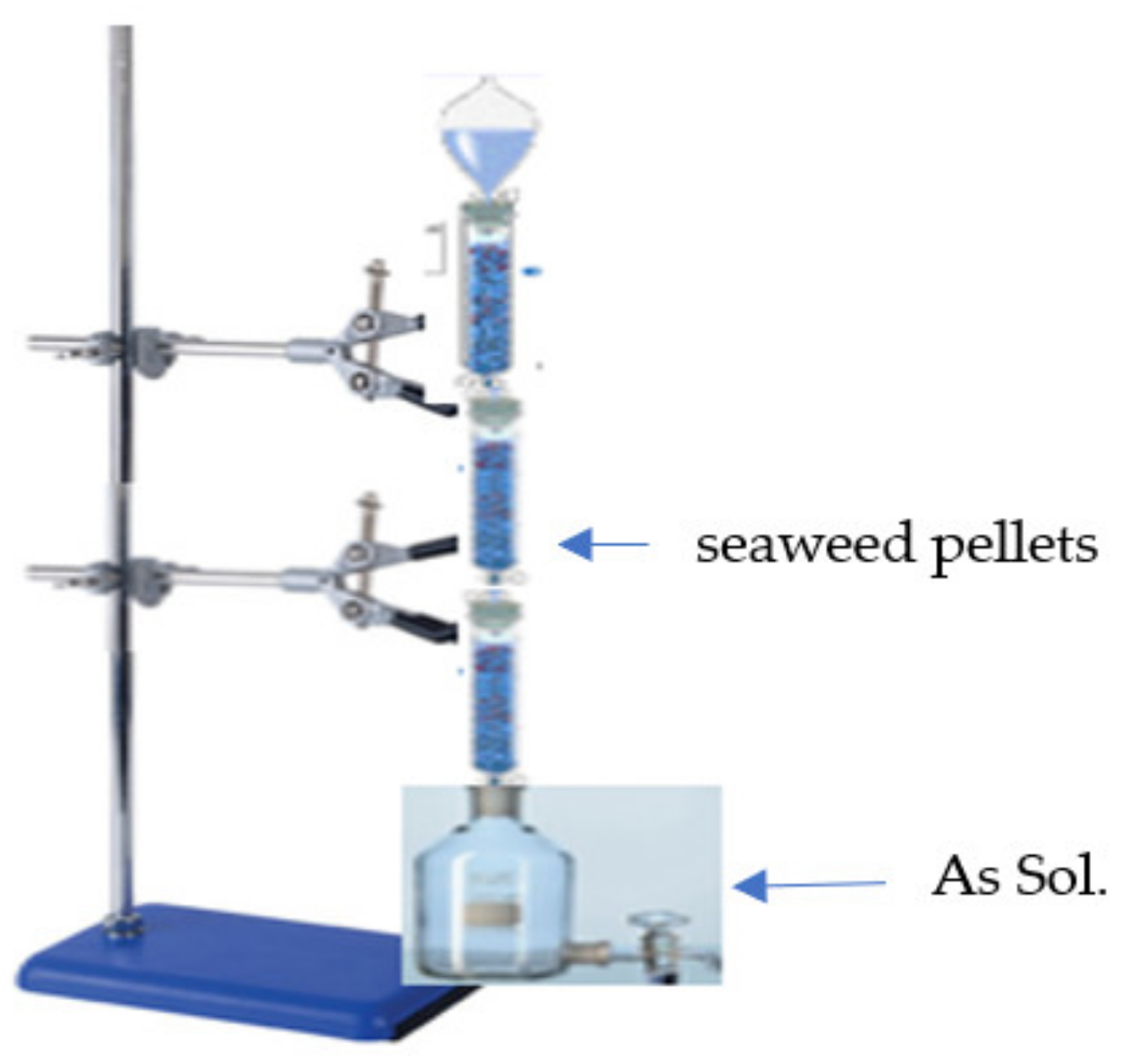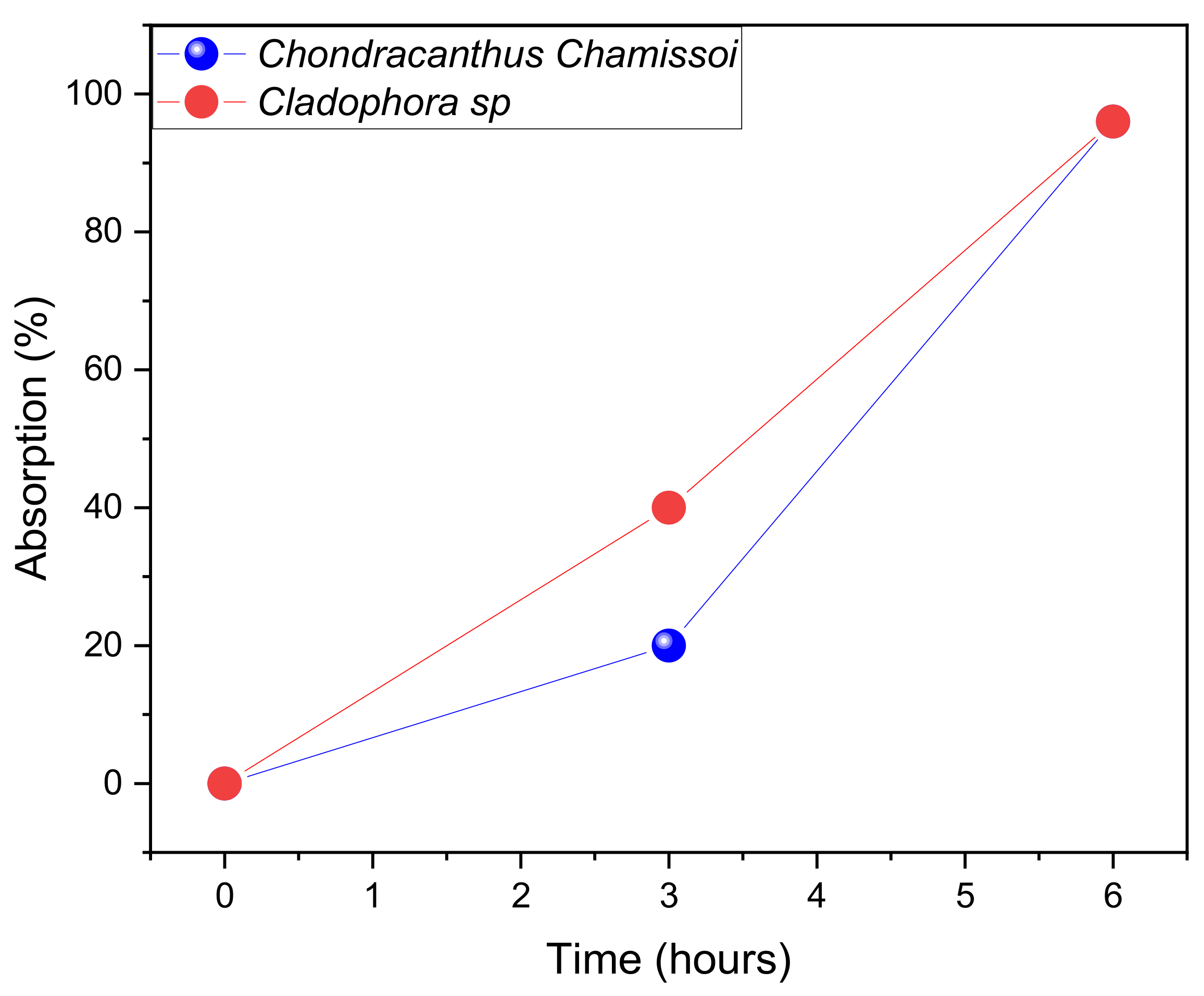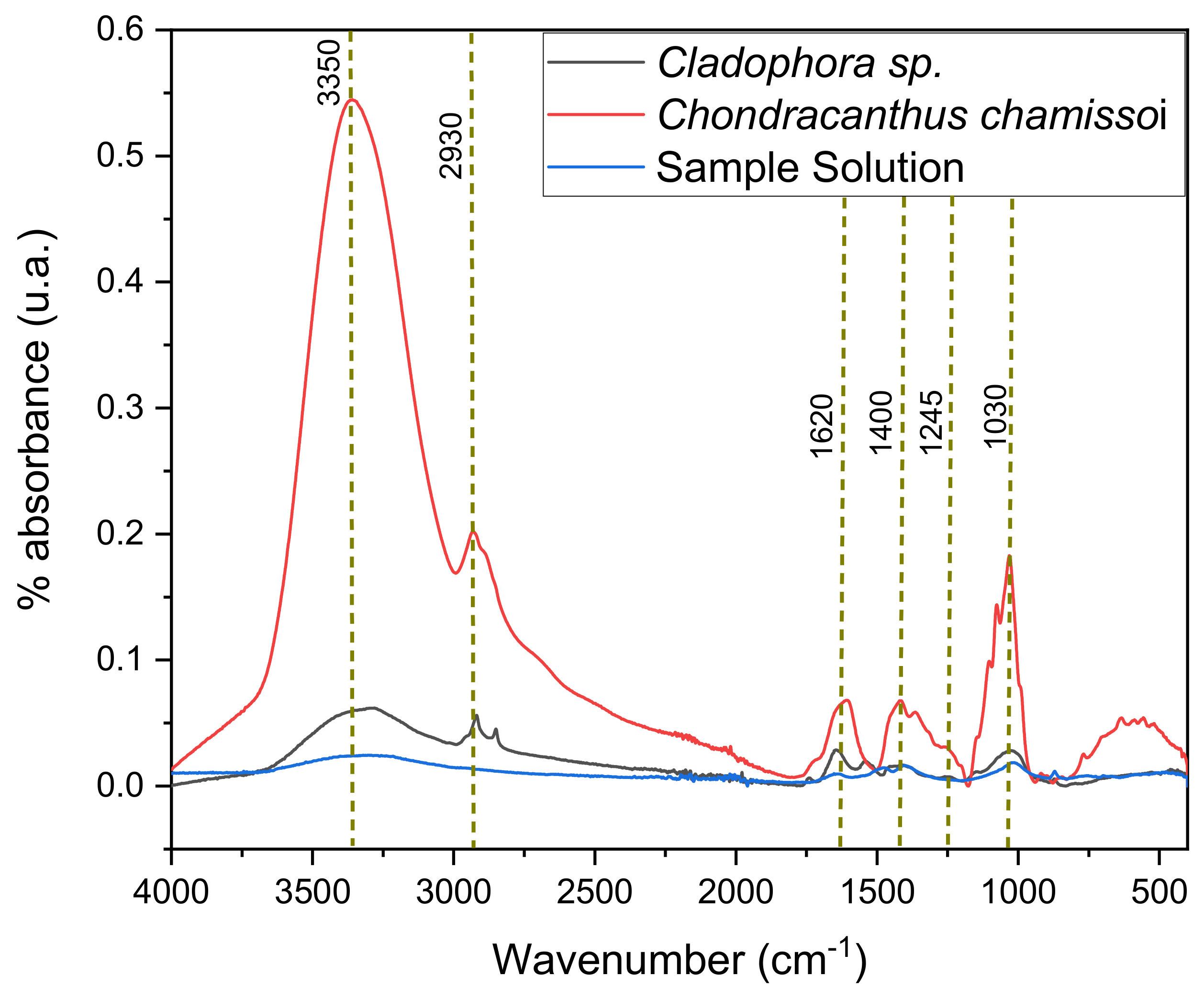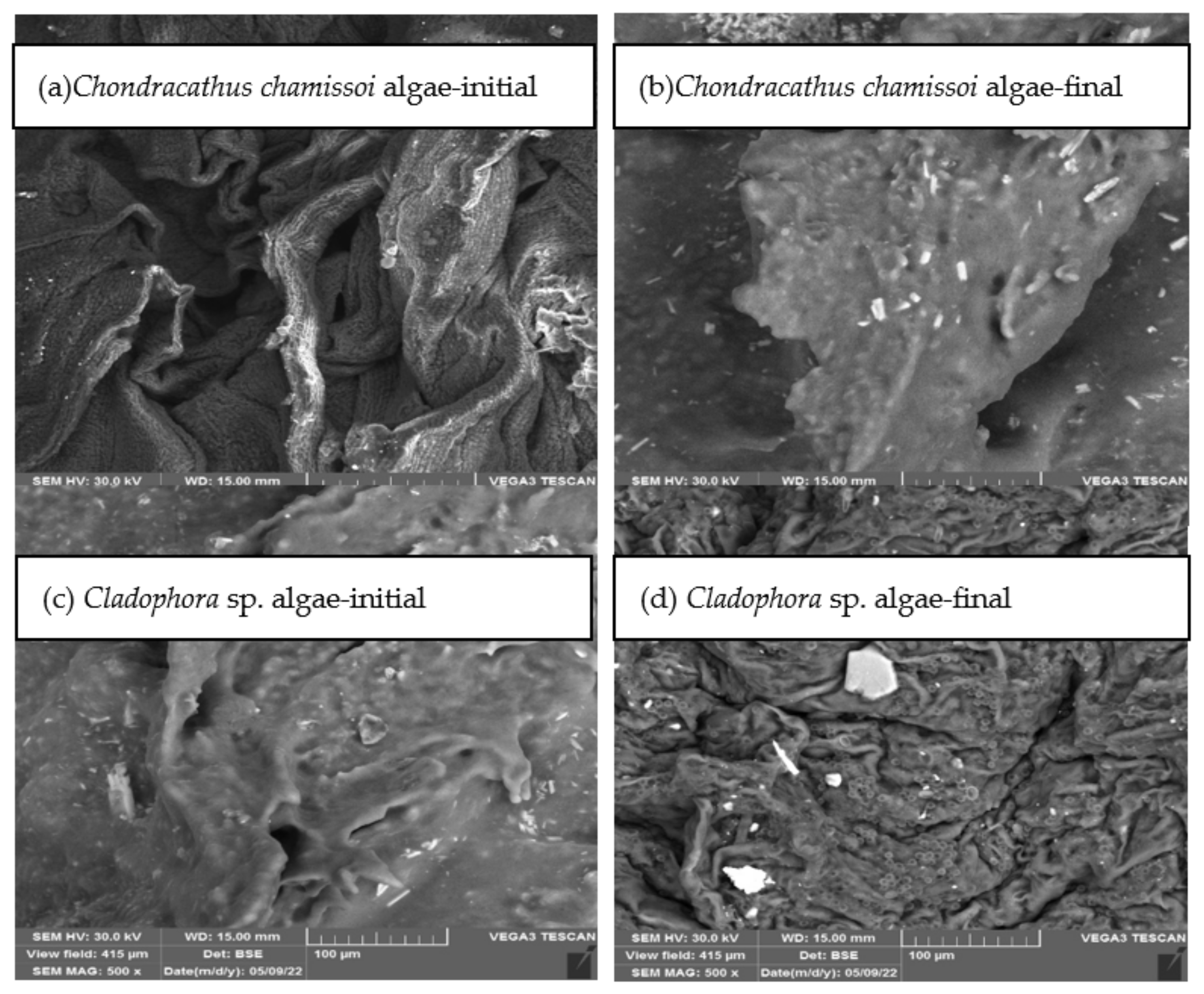Arsenic Biosorption by the Macroalgae Chondracanthus chamissoi and Cladophora sp.
Abstract
1. Introduction
2. Materials and Methods
2.1. Algae Harvesting
2.1.1. Harvesting of Chondracanthus chamissoi
2.1.2. Collection of Cladophora sp.
2.2. Transfer of Samples
2.3. Identification of the Genus and Species of Algae
2.4. Production of Algae Pellets
2.5. Preparation of as Solutions
2.6. Enabling the System for Biosorption
2.7. Identification of Functional Groups on the Surface of Algae
2.8. Evaluation of the as Biosorption by Algae
- System 1: 0.25 mg/L As solution + 2 g of Chondracanthus chamissoi pellets.
- System 2: Solution 0.25 mg/L of As + 2 g of Cladophora sp. pellets.
- System 3: Solution 1.50 mg/L of As + 2 g of Chondracathus chamissoi pellets.
- System 4: Solution 1.50 mg/L of As + 2 g of Cladophora sp. pellets.
- [As T0] = Initial concentration of As (mg/L).
- [AsT1] = Final concentration of As (mg/L).
2.9. Visualization of the Surface of Sorbents by Scanning Electron Microscopy (SEM)
2.10. Analysis of Data
2.11. Ethical Aspects
3. Results
3.1. Biosorption Percentage of Macroalgae Using a 0.25 and 1.50 mg/L as Solution
3.2. Comparison of the Biosorption Percentage of Chondracathus Chamissoi and Cladophora sp.
3.3. Identification of Functional Groups
3.4. Visualization of the Surface of Sorbents during as Biosorption by Scanning Electron Microscopy (SEM)
4. Discussion
5. Conclusions
Author Contributions
Funding
Data Availability Statement
Acknowledgments
Conflicts of Interest
References
- El Ati-Hellal, M.; Hellal, F. Heavy Metals in the Environment and Health Impact. In Environmental Health; IntechOpen: London, UK, 2021. [Google Scholar]
- Briffa, J.; Sinagra, E.; Blundell, R. Heavy Metal Pollution in the Environment and Their Toxicological Effects on Humans. Heliyon 2020, 6, e04691. [Google Scholar] [CrossRef] [PubMed]
- Palma-Lara, I.; Martínez-Castillo, M.; Quintana-Pérez, J.C.; Arellano-Mendoza, M.G.; Tamay-Cach, F.; Valenzuela-Limón, O.L.; García-Montalvo, E.A.; Hernández-Zavala, A. Arsenic Exposure: A Public Health Problem Leading to Several Cancers. Regul. Toxicol. Pharmacol. 2020, 110, 104539. [Google Scholar] [CrossRef] [PubMed]
- Ranjan, D.; Talat, M.; Hasan, S.H. Biosorption of Arsenic from Aqueous Solution Using Agricultural Residue “Rice Polish”. J. Hazard. Mater. 2009, 166, 1050–1059. [Google Scholar] [CrossRef] [PubMed]
- Barral-Fraga, L.; Barral, M.T.; MacNeill, K.L.; Martiñá-Prieto, D.; Morin, S.; Rodríguez-Castro, M.C.; Tuulaikhuu, B.-A.; Guasch, H. Biotic and Abiotic Factors Influencing Arsenic Biogeochemistry and Toxicity in Fluvial Ecosystems: A Review. Int. J. Environ. Res. Public Health 2020, 17, 2331. [Google Scholar] [CrossRef]
- Nurchi, V.M.; Djordjevic, A.B.; Crisponi, G.; Alexander, J.; Bjørklund, G.; Aaseth, J. Arsenic Toxicity: Molecular Targets and Therapeutic Agents. Biomolecules 2020, 10, 235. [Google Scholar] [CrossRef]
- Medina-Pizzali, M.; Robles, P.; Mendoza, M.; Torres, C. Ingesta de arsénico: El impacto en la alimentación y la salud humana. Rev. Peru. Med. Exp. Salud Publica 2018, 35, 93–102. [Google Scholar] [CrossRef]
- Mandal, S.; Sahu, M.K.; Patel, R.K. Adsorption Studies of Arsenic(III) Removal from Water by Zirconium Polyacrylamide Hybrid Material (ZrPACM-43). Water Resour. Ind. 2013, 4, 51–67. [Google Scholar] [CrossRef]
- Camurati, J.R.; Salomone, V.N. Arsenic in Edible Macroalgae: An Integrated Approach. J. Toxicol. Environ. Health B Crit. Rev. 2020, 23, 1–12. [Google Scholar] [CrossRef]
- Rangel, E.A.; Montanez, L.E.; Luevanos Escareño, M.P.; Balagurusamy, N. Impacto del arsénico en el ambiente y su transformación por microorganismos. Terra Latinoam. 2015, 33, 103–118. Available online: http://www.scielo.org.mx/scielo.php?script=sci_arttext&pid=S0187-57792015000200103&lng=es&nrm=iso (accessed on 15 August 2022).
- Nicomel, N.R.; Leus, K.; Folens, K.; Van Der Voort, P.; Du Laing, G. Technologies for Arsenic Removal from Water: Current Status and Future Perspectives. Int. J. Environ. Res. Public Health 2015, 13, 62. [Google Scholar] [CrossRef]
- Kabir, F.; Chowdhury, S. Arsenic Removal Methods for Drinking Water in the Developing Countries: Technological Developments and Research Needs. Environ. Sci. Pollut. Res. Int. 2017, 24, 24102–24120. [Google Scholar] [CrossRef]
- Shanab, S.; Essa, A.; Shalaby, E. Bioremoval Capacity of Three Heavy Metals by Some Microalgae Species (Egyptian Isolates). Plant Signal. Behav. 2012, 7, 392–399. [Google Scholar] [CrossRef]
- Romera, E.; González, F.; Ballester, A.; Blázquez, M.L.; Muñoz, J.A. Comparative Study of Biosorption of Heavy Metals Using Different Types of Algae. Bioresour. Technol. 2007, 98, 3344–3353. [Google Scholar] [CrossRef]
- Chojnacka, K. Biosorption and Bioaccumulation--the Prospects for Practical Applications. Environ. Int. 2010, 36, 299–307. [Google Scholar] [CrossRef]
- Bilal, M.; Rasheed, T.; Sosa-Hernández, J.; Raza, A.; Nabeel, F.; Iqbal, H. Biosorption: An Interplay between Marine Algae and Potentially Toxic Elements—A Review. Mar. Drugs 2018, 16, 65. [Google Scholar] [CrossRef]
- Javanbakht, V.; Alavi, S.A.; Zilouei, H. Mechanisms of Heavy Metal Removal Using Microorganisms as Biosorbent. Water Sci. Technol. 2014, 69, 1775–1787. [Google Scholar] [CrossRef]
- Kidgell, J.T.; de Nys, R.; Hu, Y.; Paul, N.A.; Roberts, D.A. Bioremediation of a Complex Industrial Effluent by Biosorbents Derived from Freshwater Macroalgae. PLoS ONE 2014, 9, e94706. [Google Scholar] [CrossRef]
- Zeraatkar, A.K.; Ahmadzadeh, H.; Talebi, A.F.; Moheimani, N.R.; McHenry, M.P. Potential Use of Algae for Heavy Metal Bioremediation, a Critical Review. J. Environ. Manag. 2016, 181, 817–831. [Google Scholar] [CrossRef]
- El-Naggar, N.E.-A.; Hamouda, R.A.; Mousa, I.E.; Abdel-Hamid, M.S.; Rabei, N.H. Biosorption Optimization, Characterization, Immobilization and Application of Gelidium Amansii Biomass for Complete Pb2+ Removal from Aqueous Solutions. Sci. Rep. 2018, 8, 13456. [Google Scholar] [CrossRef]
- Ibrahim, W.M. Biosorption of Heavy Metal Ions from Aqueous Solution by Red Macroalgae. J. Hazard. Mater. 2011, 192, 1827–1835. [Google Scholar] [CrossRef]
- Yipmantin, A.; Maldonado, H.J.; Ly, M.; Taulemesse, J.M.; Guibal, E. Pb(II) and Cd(II) Biosorption on Chondracanthus Chamissoi (a Red Alga). J. Hazard. Mater. 2011, 185, 922–929. [Google Scholar] [CrossRef]
- Marycz, K.; Michalak, I.; Kocherova, I.; Marędziak, M.; Weiss, C. The Cladophora Glomerata Enriched by Biosorption Process in Cr(III) Improves Viability, and Reduces Oxidative Stress and Apoptosis in Equine Metabolic Syndrome Derived Adipose Mesenchymal Stromal Stem Cells (ASCs) and Their Extracellular Vesicles (MV’s). Mar. Drugs 2017, 15, 385. [Google Scholar] [CrossRef]
- Christobel, J.; Lipton, A.P. Evaluation of Macroalgal Biomass for Removal of Heavy Metal Arsenic (As) from Aqueous Solution. Available online: https://www.ijaiem.org/Volume4Issue5/IJAIEM-2015-04-13-35.pdf (accessed on 16 August 2022).
- Huaranga Moreno, F.; Méndez García, E.; Quilcat León, V.; Huaranga Arévalo, F. Pollution by Heavy Metals in the Moche River Basin, 1980–2010, La Libertad—Peru. Sci. Agropecu. 2012, 3, 235–247. [Google Scholar] [CrossRef]
- Osores Plenge, F.; Rojas Jaimes, J.E.; Manrique Lara Estrada, C.H. Minería Informal e Ilegal y Contaminación Con Mercurio En Madre de Dios: Un Problema de Salud Pública. Acta Médica Peru 2012, 29, 38–42. [Google Scholar]
- Beltrán, R.; Gonza, K. Cytotoxicity and Genotoxicity of the Waters of the Jequetepeque and Moche Rivers in the Environmental Bioindicator Vicia Faba L. Sci. Agropecu. 2017, 8, 203–213. [Google Scholar] [CrossRef][Green Version]
- Claves Dicotómicas Para Identificación de Algas 1. Available online: https://www.yumpu.com/es/document/view/13303918/claves-dicotomicas-para-identificacion-de-algas-1- (accessed on 16 August 2022).
- Filote, C.; Ungureanu, G.; Boaventura, R.; Santos, S.; Volf, I.; Botelho, C. Green Macroalgae from the Romanian Coast of Black Sea: Physico-Chemical Characterization and Future Perspectives on Their Use as Metal Anions Biosorbents. Process Saf. Environ. Prot. 2017, 108, 34–43. [Google Scholar] [CrossRef]
- Ley sobre la Conservación y el Aprovechamiento Sostenible de la Diversidad Biológica. Available online: https://sinia.minam.gob.pe/normas/ley-conservacion-aprovechamiento-sostenible-diversidad-biologica (accessed on 16 August 2022).
- Ahmad, A.; Bhat, A.H.; Buang, A. Biosorption of Transition Metals by Freely Suspended and Ca-Alginate Immobilised with Chlorella Vulgaris: Kinetic and Equilibrium Modeling. J. Clean. Prod. 2018, 171, 1361–1375. [Google Scholar] [CrossRef]
- Xiong, Q.; Hu, L.-X.; Liu, Y.-S.; Wang, T.-T.; Ying, G.-G. New Insight into the Toxic Effects of Chloramphenicol and Roxithromycin to Algae Using FTIR Spectroscopy. Aquat. Toxicol. 2019, 207, 197–207. [Google Scholar] [CrossRef]
- Benaisa, S.; Arhoun, B.; El Mail, R.; Rodriguez-Maroto, J.M. Potential of Brown Algae Biomass as New Biosorbent of Iron: Kinetic, Equilibrium and Thermodynamic Study. Available online: https://www.jmaterenvironsci.com/Document/vol9/vol9_N7/233-JMES-3963-Benaisa.pdf (accessed on 16 August 2022).
- EPA (Environmental Protection Agency). Edition of the Drinking Water Standards and Health Advisories; (EPA/822-R-06-013); Environmental Protection Agency: Washington, DC, USA, 2006. Available online: https://agri.idaho.gov/main/wp-content/uploads/2018/03/epa_drinking_water_standard-2006.pdf (accessed on 15 August 2022).
- Davis, T.A.; Volesky, B.; Mucci, A. A Review of the Biochemistry of Heavy Metal Biosorption by Brown Algae. Water Res. 2003, 37, 4311–4330. [Google Scholar] [CrossRef]
- Michalak, I. The Application of Seaweeds in Environmental Biotechnology. In Advances in Botanical Research; Elsevier: Amsterdam, The Netherlands, 2020; pp. 85–111. ISBN 9780081027103. [Google Scholar]
- Lu, W.; Xu, Y.; Liang, C.; Musah, B.I.; Peng, L. Simultaneous Biosorption of Arsenic and Cadmium onto Chemically Modified Chlorella Vulgaris and Spirulinaplatensis. Water 2021, 13, 2498. [Google Scholar] [CrossRef]
- Santos, S.C.R.; Ungureanu, G.; Volf, I.; Boaventura, R.A.R.; Botelho, C.M.S. Macroalgae Biomass as Sorbent for Metal Ions. In Biomass as Renewable Raw Material to Obtain Bioproducts of High-Tech Value; Elsevier: Amsterdam, The Netherlands, 2018; pp. 69–112. [Google Scholar]
- Jasrotia, S.; Kansal, A.; Kishore, V.V.N. Arsenic Phyco-Remediation by Cladophora Algae and Measurement of Arsenic Speciation and Location of Active Absorption Site Using Electron Microscopy. Microchem. J. 2014, 114, 197–202. [Google Scholar] [CrossRef]
- Rangabhashiyam, S.; Balasubramanian, P. Characteristics, Performances, Equilibrium and Kinetic Modeling Aspects of Heavy Metal Removal Using Algae. Bioresour. Technol. Rep. 2019, 5, 261–279. [Google Scholar] [CrossRef]
- Lee, X.J.; Ong, H.C.; Ooi, J.; Yu, K.L.; Tham, T.C.; Chen, W.-H.; Ok, Y.S. Engineered Macroalgal and Microalgal Adsorbents: Synthesis Routes and Adsorptive Performance on Hazardous Water Contaminants. J. Hazard. Mater. 2022, 423, 126921. [Google Scholar] [CrossRef] [PubMed]
- Gupta, V.K.; Rastogi, A.; Nayak, A. Biosorption of Nickel onto Treated Alga (Oedogonium Hatei): Application of Isotherm and Kinetic Models. J. Colloid Interface Sci. 2010, 342, 533–539. [Google Scholar] [CrossRef] [PubMed]
- Dhankhar, R.; Hooda, A. Fungal Biosorption--an Alternative to Meet the Challenges of Heavy Metal Pollution in Aqueous Solutions. Environ. Technol. 2011, 32, 467–491. [Google Scholar] [CrossRef]





| Solution 0.25 mg/L | ||
|---|---|---|
| As Concentration (mg/L) | Chondracanhtus chamissoi | Cladophora sp. |
| Initial | 0.25 mg/L | 0.25 mg/L |
| At 3 h | 0.20 mg/L | 0.15 mg/L |
| At 6 h | <0.01 mg/L | <0.01 mg/L |
| Solution 1.50 mg/L | ||
| Initial | 1.50 mg/L | 1.50 mg/L |
| At 3 h | 1.31 mg/L | 1.31 mg/L |
| At 6 h | 0.22 mg/L | 0.87 mg/L |
| 3 Hours | 6 Hours | |||||
|---|---|---|---|---|---|---|
| In As solution 0.25 mg/L | ||||||
| Alga | Mean | Standard deviation | Significance (t-test) | Mean | Dev. Standard | Significance (t-test) |
| Chondracanthus chamissoi | 20.40 | 0.4 | <0.05 | 95.76 | 0.48 | >0.05 |
| Cladophora sp. | 40.27 | 0.23 | 95.76 | 0.48 | ||
| In As solution 1.50 mg/L | ||||||
| Chondracanthus chamissoi | 12.66 | 0.051 | >0.05 | 85.33 | 1.33 | < 0.05 |
| Cladophora sp | 12.66 | 0.06 | 42.03 | 0.92 | ||
Publisher’s Note: MDPI stays neutral with regard to jurisdictional claims in published maps and institutional affiliations. |
© 2022 by the authors. Licensee MDPI, Basel, Switzerland. This article is an open access article distributed under the terms and conditions of the Creative Commons Attribution (CC BY) license (https://creativecommons.org/licenses/by/4.0/).
Share and Cite
Otiniano, N.M.; De La Cruz-Noriega, M.; Cabanillas-Chirinos, L.; Rojas-Flores, S.; Muñoz-Ríos, M.A.; Rojas-Villacorta, W.; Robles-Castillo, H. Arsenic Biosorption by the Macroalgae Chondracanthus chamissoi and Cladophora sp. Processes 2022, 10, 1967. https://doi.org/10.3390/pr10101967
Otiniano NM, De La Cruz-Noriega M, Cabanillas-Chirinos L, Rojas-Flores S, Muñoz-Ríos MA, Rojas-Villacorta W, Robles-Castillo H. Arsenic Biosorption by the Macroalgae Chondracanthus chamissoi and Cladophora sp. Processes. 2022; 10(10):1967. https://doi.org/10.3390/pr10101967
Chicago/Turabian StyleOtiniano, Nélida Milly, Magaly De La Cruz-Noriega, Luis Cabanillas-Chirinos, Segundo Rojas-Flores, Miguel A. Muñoz-Ríos, Walter Rojas-Villacorta, and Heber Robles-Castillo. 2022. "Arsenic Biosorption by the Macroalgae Chondracanthus chamissoi and Cladophora sp." Processes 10, no. 10: 1967. https://doi.org/10.3390/pr10101967
APA StyleOtiniano, N. M., De La Cruz-Noriega, M., Cabanillas-Chirinos, L., Rojas-Flores, S., Muñoz-Ríos, M. A., Rojas-Villacorta, W., & Robles-Castillo, H. (2022). Arsenic Biosorption by the Macroalgae Chondracanthus chamissoi and Cladophora sp. Processes, 10(10), 1967. https://doi.org/10.3390/pr10101967







